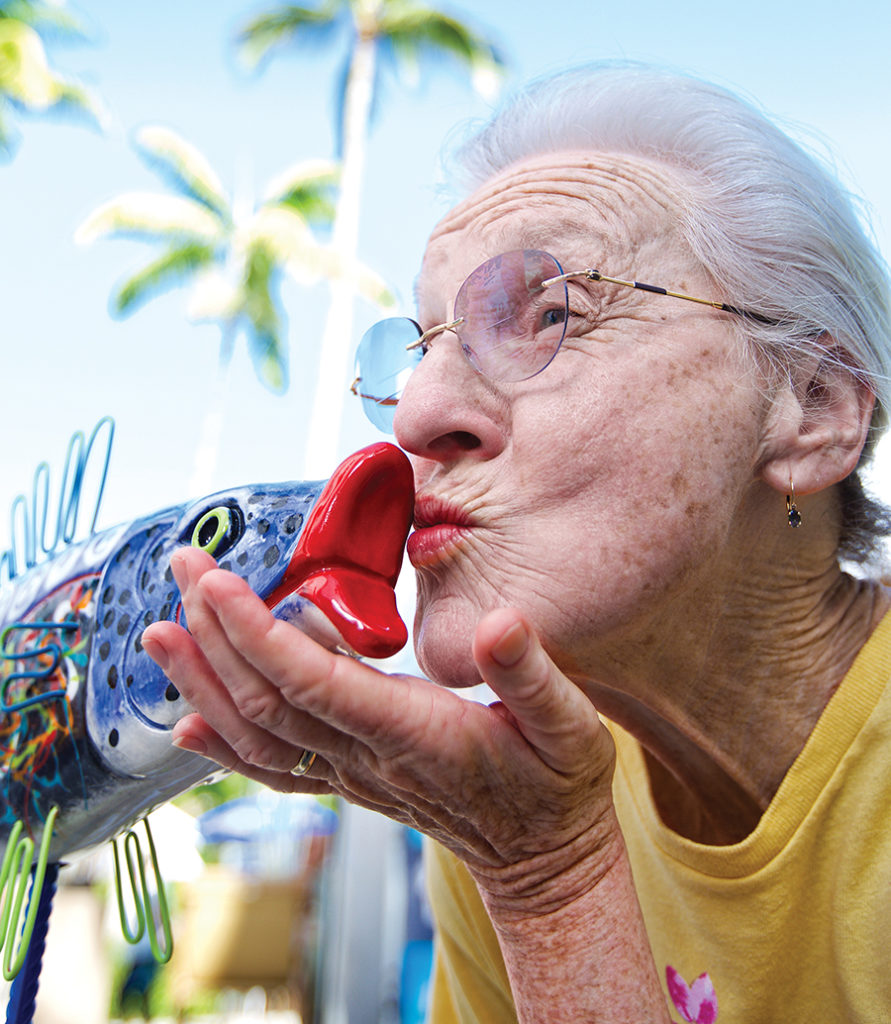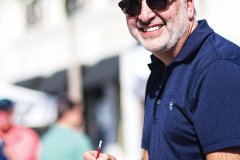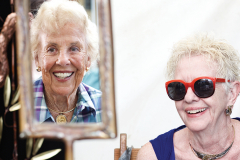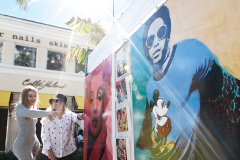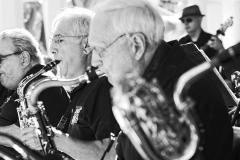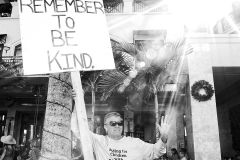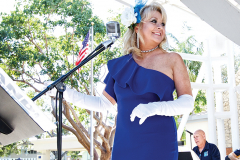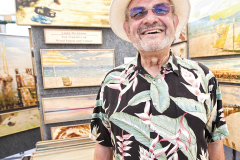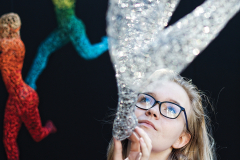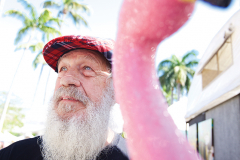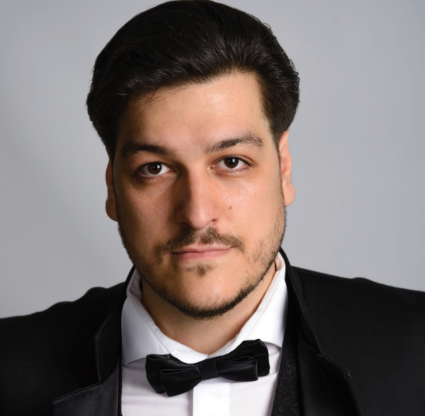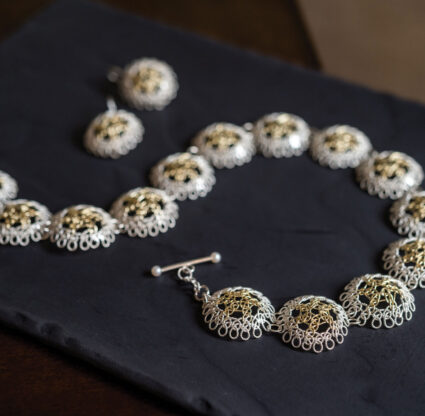On a bright weekend morning in January, on a Fifth Avenue free of cars, artist Randi Grantham stands inside his open–air booth at the Naples New Year’s Art Show, smiling next to his bronze sculptures.
The art show will draw more than 15,000 people over the course of the weekend, and many of them will pass by Grantham’s booth. Just about all of them, it seems, will have something to say.
“What is this, a coconut?” one older woman asks the trio of women she’s with.
They all eye the bronze sculpture, which is, indeed, a coconut. It just happens to be the size of a microwave.
After the group of women has moved on, a middle-aged couple stops to peer at the piece.
“It’s a coconut,” the man explains to his wife, and she nods enthusiastically.
They walk on, and a father and a son pause.
“That’s a big coconut,” the boy says, eyes wide.
When they’ve left, a man in a red polo and a gleaming gold wristwatch stops and runs his hand admiringly over the coconut. He nods to himself, once, as if in approval, before continuing.
“I just love doing these types of shows because of the reactions from people,” says Grantham, who’s based in West Palm Beach. “There’s a really high-quality mentality over here in Naples. There’s a sense of joy and happiness. People are happy to see my work. I sell other places, but Naples is by far my better show. There’s something about Naples that attracts a certain type of person—they love art and they buy art. People support the arts here like no other place.
Grantham’s booth features other bronze sculptures besides the microwaved-size coconut. There’s a giant dried chili pepper, green pears the size of a man’s head, knee-high cherries, a pineapple like an end table and a larger-than-life green olive titled Dean Martini.
The commentary from the steady stream of passersby goes something like this:
“This is insane. They look real.”
“That olive needs a martini glass.”
“I like that red pepper right there.”
“El tomate, la pina.”
“How much is the tomato?” someone asks Grantham.
“That is $3,500,” he answers. “It’s all bronze.”
Two women in visors and workout leggings stop to touch the long-stemmed cherry with the tips of their fingers.
Grantham sidles up to them. “It’s bronze.”A woman in a pink button-down and a long string of pearls draped around her neck points to a larger-than-life slice of cantaloupe as she passes.“Kind of looks like you want to take a bite,” she calls out.
“After I clean the seeds off,” Grantham says.
The woman laughs. “After you clean the seeds, sure.”
Palm fronds rustle overhead. A plastic canvas snaps in the breeze. The sky is a clear, cloudless blue. It’d be possible to spend all day at Grantham’s booth, listening to the art-show-goers and their endless commentary on his work, but there are 232 other artists at the show and a world of art to explore—pottery, woodwork, jewelry, metalwork, glass sculptures, batik, photography and paintings in watercolor, acrylic and oils. Four hundred and thirty-two artists applied to be in the show, and a little more than half were invited. To be considered, artists had to submit samples of their work plus a photo of their booth. The jurying process for the show was blind, which means each artist’s name, pedigree and geographic location were irrelevant. Only the quality of the work mattered.
The Naples community is widely represented at the art show, with an endless stream of khakis and Ray-Bans, sundresses and sandals. But the day is full of quirky surprises—a man strolling with three cockatoos on his shoulders, a woman walking her tie-dyed poodle, more dogs in strollers than babies.
At Linda McAdams’ booth of gel-release transfers of Polaroid images on wood panels, husband and wife Al and Phyllis Hardy, visiting from Ohio, stop to admire the work. The Hardys own a bed and breakfast, and Al is an interior designer and runs a furniture store inherited from his father. The pair have a condo in Naples that they escape to throughout the year. The Hardys have been coming to the art show for the last five years, and they make it a priority to visit when they’re in town.
“We’ve visited art shows up in Ohio,” says Al Hardy, “but I think Naples is by far the superior one. It’s just exciting to walk through and see people buying. And a lot of it is timeless art. There’s things that you can buy that 20 to 25 years from now you can look at and say, ‘Isn’t that neat?’ They don’t have a lot of disposable art at the Naples show.”
At his furniture store in Ohio, Hardy sells a blend of vintage and antique pieces as well as contemporary furnishings. It’s all American-made, he says, with a quality that endures.
“I like art and things that never go out of style. The artists at the Naples show are proud of their different talents, and they explain how they do it. The glass vendors, the oil painters, the lady who does these Polaroid images where she applies it to a woodgrain board—you’re not just buying something to make a change in your residence but you’re adding a timeless piece to it. It’s a wonderful show for people that appreciate quality merchandise, and it’s so nice to be able to talk to the artists versus just seeing the work displayed in somebody’s store.”
At some booths, art-show-goers can do more than just speak to the artists. They can watch them create. On Park Street, just off Fifth Avenue and near the Naples Art Association, the Art in the Park exhibition is also taking place. This, too, is a juried show, but its artist slots are reserved for members of the Naples Art Association. Near his booth on Park, painter Shah Hadjebi leans over the painting on his easel. He takes slow, meticulous strokes, dipping his brush in a small palette he carries in his left hand. A man on a scooter eating a Polish sausage rides up and stops to watch. The sun is white-hot now, and it slices down as he works. The man on the scooter motors on, and a man in flamingo-pink shorts and a white polo, toothpick tucked into the corner of his mouth, stops next.
“What kind of paper is that?” the man asks.
“One hundred and forty-pound Canson paper,” Hadjebi tells him.
“Do you get it at Michael’s?”
Hadjebi laughs. “No, Michael’s doesn’t carry this brand at this size.”
The man nods thoughtfully. Gazing at the pieces Hadjebi has on display in his booth, he asks, “How long does it take you to finish one of these?”
“Overall, it takes me about two weeks.”
“How many hours?”
“A couple of hours a day on each painting since I work on several paintings at the same time.”
The man leans close and inspects one of the paintings. “Did you put something underneath to create the highlights?”
“Yes, I used masking fluid. It’s like rubber cement,” Hadjebi says. “All the white parts are actually paper. My wife said that the pure white highlights on one of my cars looked like bird poop. So, I’ve learned to dull them a bit since then.”
The man chuckles. “She’s kind of right. It would look like bird poop.”
Hadjebi smiles. “She’s not a watercolorist, but she has a good eye for these things.”
For Hadjebi, who’s a member of Tower Gallery on Sanibel and has done three shows with the Naples Art Association, this type of exchange is what the art show experience is all about.
“I like talking with people as I paint my artwork,” he says. “It becomes an interaction, and their interaction changes my painting.”
With the Art in the Park piece, for example, people asked him about a series of small round circles, wondering aloud what they were. Hadjebi would ask them, in turn, “What do you think they are?” One woman suggested oranges; another said, “Sand dollars.” Hadjebi incorporated both into the finished painting.
“I used to be a musician,” he explains, “and I was on stage a lot. It was really fun to interact with people. So, when I paint at a show, it becomes more like a performance. It’s like having a gig.”
On this particular weekend, Hadjebi wasn’t the only gig in town. Mid-
afternoon on Sunday, another kind of show was setting up in Cambier Park. The players of the Naples Big Band were readying their instruments, running a cloth a final time over the brass, adjusting mouthpieces and, in the case of vocalist Amy Bright, slipping into her show gown. Bright works in advertising by day, and at night she’s a “canary for hire” (her words), singing in various bands around town. The Naples Big Band, though, has her heart.
“I’m a little biased about this band,” she admits, “because big band music is my passion.”
Bright says singing with the Naples band in front of a live audience is the most energizing thing in her life.
“We’re all working hard up there. We want people to feel like they’re transported, that it was an experience and not just a concert. We want to connect with the audience and move them, whether it’s to smile or sing along. Sometimes tears come up because it evokes memories. It’s that exchange we have with audience members; that’s why we’re up there. Music is a connector between people. When we’re on and we’re connecting with the audience, we all literally and figuratively feel it in our bones. We can just sense that the audience is loving it.”
The Naples community, she says, is particularly receptive to this kind of connection.
“The Naples audience are loyal music lovers. Just look at Cambier Park—the band shell is the heart of the park. Not every park has a band shell like this one; it tells us that live concerts resonate with this community, that the arts community is alive and well in this town.”
At 2:03 p.m., the Naples Big Band opens the show with a big sound. The band leader, Jim Castaldi, says to the audience, “We ordered the weather just for you today,” and a pleased titter crosses the rows of camp chairs that fill the park. “We’re so glad that you’re here,” he continues. “You’re going to hear some of your favorites—Duke Ellington, Henry Mancini, Billy Strayhorn and many, many more.”
Applause and a few woos go up across the park. Castaldi launches the band with, “A one, a two, a one, two…” and the sounds of Duke Ellington’s Caravan rise through the laurel oaks and the gumbo limbos. The symbols tap, tap, tap, the horns blare, and the bass strums while the keyboard makes its jangly music and the concert-goers snap and clap and bob their heads along with the music. Look down any aisle, and toes are tapping in white sneakers, tasseled loafers, strappy sandals, sandals with socks and, here and there, cowboy boots.
At the end of Caravan, Bright strides to the front of the stage. She’s wearing a long blue dress, white elbow gloves and a white flower clipped above her ear. Rhinestone earrings dangle to her shoulders. She takes the microphone in both hands as emcee Todd Irby says, “This is a tune from Irving Berlin. It’s perfect for today because it’s such a beautiful day. The song is called Blue Skies. Ladies and gentlemen, the Naples Big Band.”
Castaldi takes the band into the next song, and Bright shimmies as she sings, moving to the sounds of the brass. Audience feet tap in the brown mulch and hands keep time against thighs. A line of ladies with walkers smiles up at the stage.
When Bright’s bluesy voice simmers to a close, the band slides into the next song, a trumpet medley. A cool breeze coasts across the park as the big-band beats rise from the stage. The park is filled with the sound of it, and the music drifts over to Fifth Avenue, where the art show is still taking place. The arts are ecstatically alive and vibrant on this weekend in downtown Naples.

